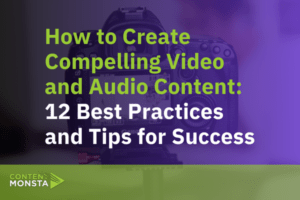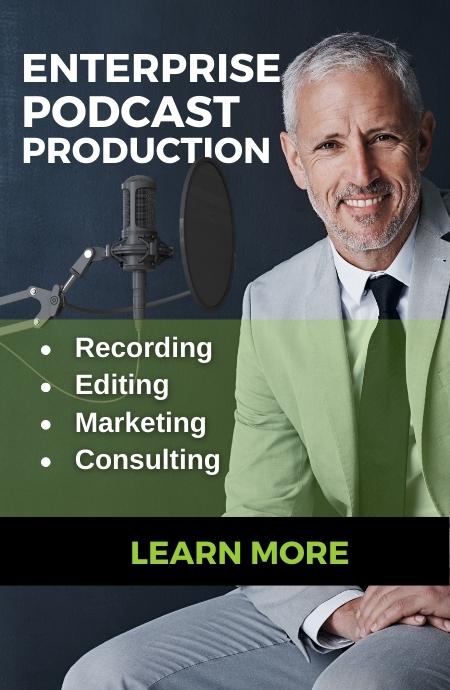Our picks for the best podcast microphones come from testing, understanding the needs of the user, and knowing the brands that make the microphones.
The foundation of a successful podcast is an excellent connection between the speaker’s voice and the listener’s ear. That reality makes the microphone used for a podcast the most important piece of equipment needed for production.
Let’s look at the different types of microphones currently popular with podcasters, and discuss our top choices for 2023.
Dynamic Microphones vs. Condenser Microphones
First, it’s important to know a little about the two main types of microphone technologies. Podcast-level microphones come in two versions: dynamic and condenser.
You don’t have to learn much about the differences, except to understand that where and how you intend to use the mic can make a tremendous impact on which type of mic you will want.
Dynamic Microphones
Dynamic microphones work like an ear. Internal coils that act as an eardrum, vibrate and then send out sound to the brain, or speaker, where it is recognized and translated. They offer clear sound with low noise and good tonal quality.
Dynamic mics are simple, sturdy, and usually, less expensive. They do not require a battery or other power source to operate and are most often used for live events and podcasting.
These mics traditionally have professional XLR inputs, but the newer models that we will suggest in this article also will have USB connections to connect directly to your computer.
Pros
- Less sensitive to background noise
- Works better in noisy environments
- High audio quality for most users
- Durable
- No power source required
- Cost-effective
- Tolerant of heat and humidity
- Also available with USB connections
Cons
- Bulky and heavy
- Less sensitivity (also a pro)
- Lower audio quality than pro studio mics
- Slower response time
Condenser Microphones
Condenser microphones rely on a power source, either AC or batteries. This needed power is referred to as Phantom Power.
They come either USB or XLR ready, or can be adapted for either. They can be plugged directly into a computer if the USB provides sufficient power to the mic.
Condenser mics are extremely sensitive and will pick up any sounds in a room whether desired or not. They can be very small and tend to be more fragile and more expensive than dynamic mics.
While some models of these mics (like the Blue Yeti) have become very popular for home studio or desk use, these mics are preferred for in-studio and film productions where sound is highly controlled.
Pros
- Sensitive to all sounds (can be a con if room is noisy)
- Can be very small
- Good audio quality
- Smooth frequency response
Cons
- Not ideal for spaces without acoustic treatment or noise
- Fragile
- More expensive
- Pulls in background noise
Because most people do not know how to properly use a condenser mic, we do not suggest the popular Blue Yeti microphone for podcasting. The Blue Yeti is a side-address rather than an end-address condenser microphone with multiple pickup patterns. Few people have a room with the acoustic treatment needed to successfully use this mic.
How to Choose Between Dynamic and Condenser Microphones
Choosing between a dynamic and a condenser microphone for a podcast comes down to how and where it will be used.
If background noise is involved such as outdoor sounds, people in the building, or even an air conditioner, a dynamic mic will be best. Also, if the equipment has to be moved often or there are multiple people speaking in the same room, a dynamic mic is best.
If the room is acoustically treated, there is no background noise, and a professional audio interface is in use, a condenser mic can work.
The Best Dynamic Mics for Podcasting
We suggest dynamic microphones for podcasting mainly because of the pickup pattern and the ability to reject unwanted sound. A cardioid pick-up pattern gives the microphone the ability to reject distant sounds and capture a single source situated directly in front of the microphone.
Primary applications include podcasting, live sound, studio recording, web-streaming, and conferencing.
Dynamic mics are more durable and cost-effective than condenser mics and are our top choices for podcasts.
This article contains Amazon affiliate links. All of the products we highlight are recommended for their quality, performance, and overall reputation regardless of any affiliate relationships.
As an Amazon Associate, Content Monsta may earn commissions from qualifying purchases from Amazon.com.
Very Good
The following dynamic microphones connect to your laptop via USB connection. They also have XLR connections should you decide to upgrade to a multi-mic studio. Either of these are a good choice for the beginning podcaster who wants to get a feel for things before investing in a more costly mic.
- Samson Q2U: The Samson Q2U is well-priced and combines the convenience of digital and analog audio capture into one dynamic microphone. With both XLR and USB outputs, it is easy to set up and outshines microphones that cost twice as much.
- Audio-Technica ATR2100x-USB: The versatile ATR2100x-USB offers a high-quality analog to digital converter with the ability to handle 24-bit/192kHz audio for excellent fidelity. This rugged microphone also supports both USB and XLR connections and features a headphone jack with level control for direct monitoring.
Better
Built for broadcast-level professional quality audio, these mics also come at reasonable prices. While they both operate best when connected to an audio interface using an XLR connection, The Shure MV7 can also connect via USB.
- Rode PodMic: The PodMic is a broadcast-grade dynamic microphone designed specifically for podcasts. It can be used with any XLR interface and delivers an easy-to-listen-to tone that audiences love.
- Rode PodMic USB: An upgrade from the original PodMic, the PodMic USB has both XLR and USB Connectivity specifically for podcasts. It can be plugged directly into your computer or used with any XLR interface.
- Shure MV7: Offering legendary broadcast sound, the Shure MV7 costs a little more because it is more advanced. It can be considered the little brother of the SM7B mentioned below. Specialized features include an integrated touch panel for mic controls and a companion app for sonic optimization. It interfaces via USB or SLR.
Pro
These microphone suggestions are aimed at the professional podcaster who wants a radio broadcast level sound, understands pro audio equipment, and is committed to long-term podcasting.
- Shure SM7B: For professional podcasts, broadcasting, or studio recordings, the SM7B gives a smooth, flat, wide-range frequency response that is appropriate in all professional applications. A step-up in price, it captures and enhances the finer details of the human voice while blocking out background noise. It has a frequency range of 50 Hz to 20 kHz and connects via XLR. This mic has come to dominate high-level podcasting.
- Electro-Voice RE20: The most expensive microphone on our list is the Electro-Voice RE20. With its Variable-D design and voice-tailored frequency response, this true cardioid announcer microphone gives the classic sound of FM radio voices. Truly an industry standard, it has a frequency range of 45 Hz to 18 kHz and weighs just over one pound. The RE20 delivers reliable, low-noise audio with exceptional clarity and definition.
The Wrap
The microphone you choose to present yourself to the world needs to be high quality, but it doesn’t have to cost a fortune. A reliable dynamic microphone will give you the sound quality you desire while fitting within your budget and being easy to use.
As you can see, “price” is not a determination of what is better for you. The reason, the room, and the purpose should be the key indicators of which microphone is best for you.

The Importance of Video Content in AI-Driven Search
AI-driven generative search engines reshape how information is discovered and consumed, video content is gaining an edge in visibility, engagement, and credibility.

The Advantage of Executive Led Video Content
Unlock the full potential of your brand with executive-led video content, a powerful tool proven to build credibility and drive engagement. Discover how thought leadership videos not only boost visibility but also influence buyer behavior, securing a competitive edge in the B2B sector.

How to Create Compelling Video and Audio Content: 12 Best Practices and Tips for Success
Creating engaging video and audio content is crucial for marketers. Learn essential strategies to elevate your content game. Whether you’re a seasoned creator or just starting out, these tips will help you connect with your audience more effectively. Discover how to make your content truly resonate.





